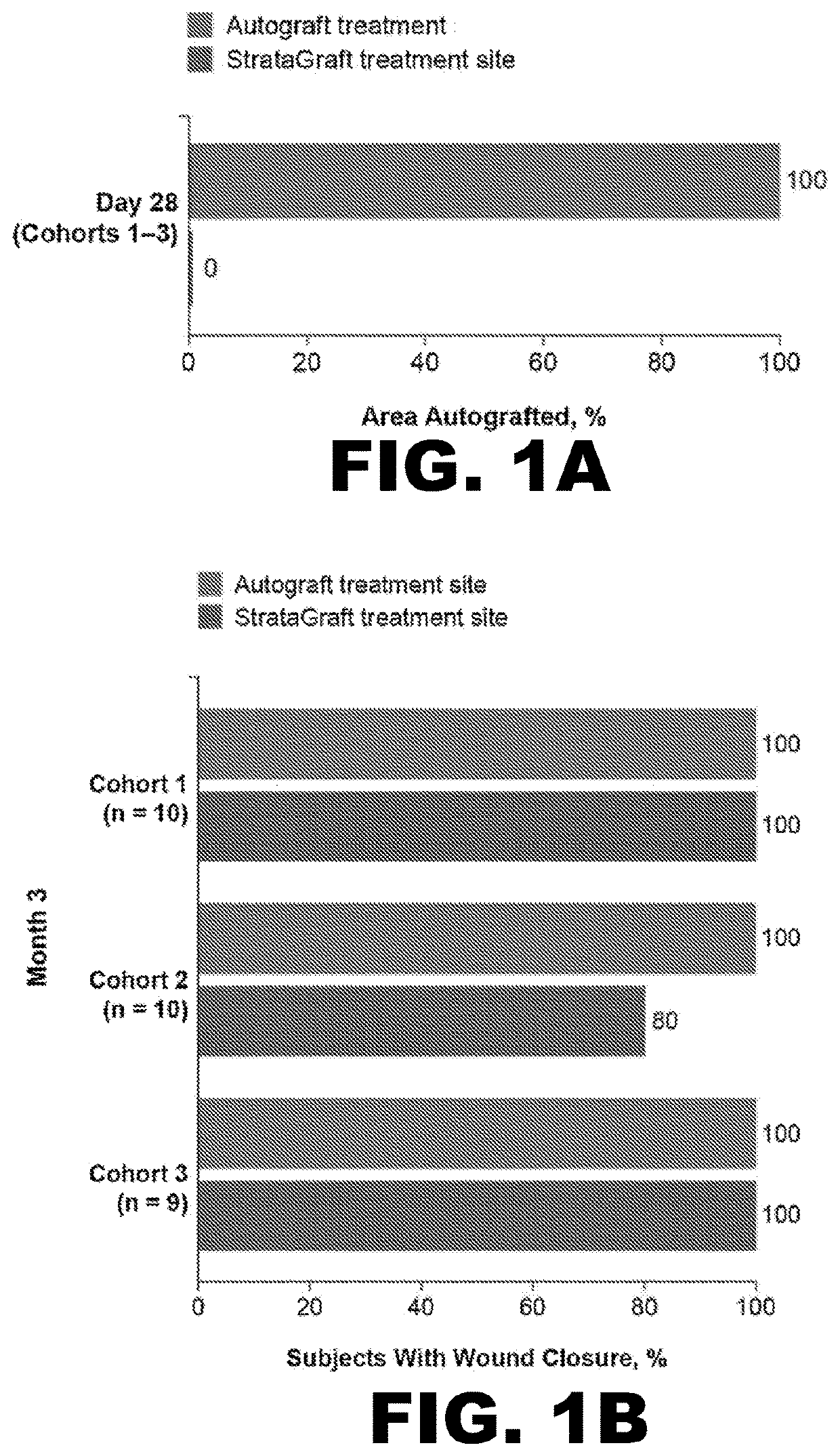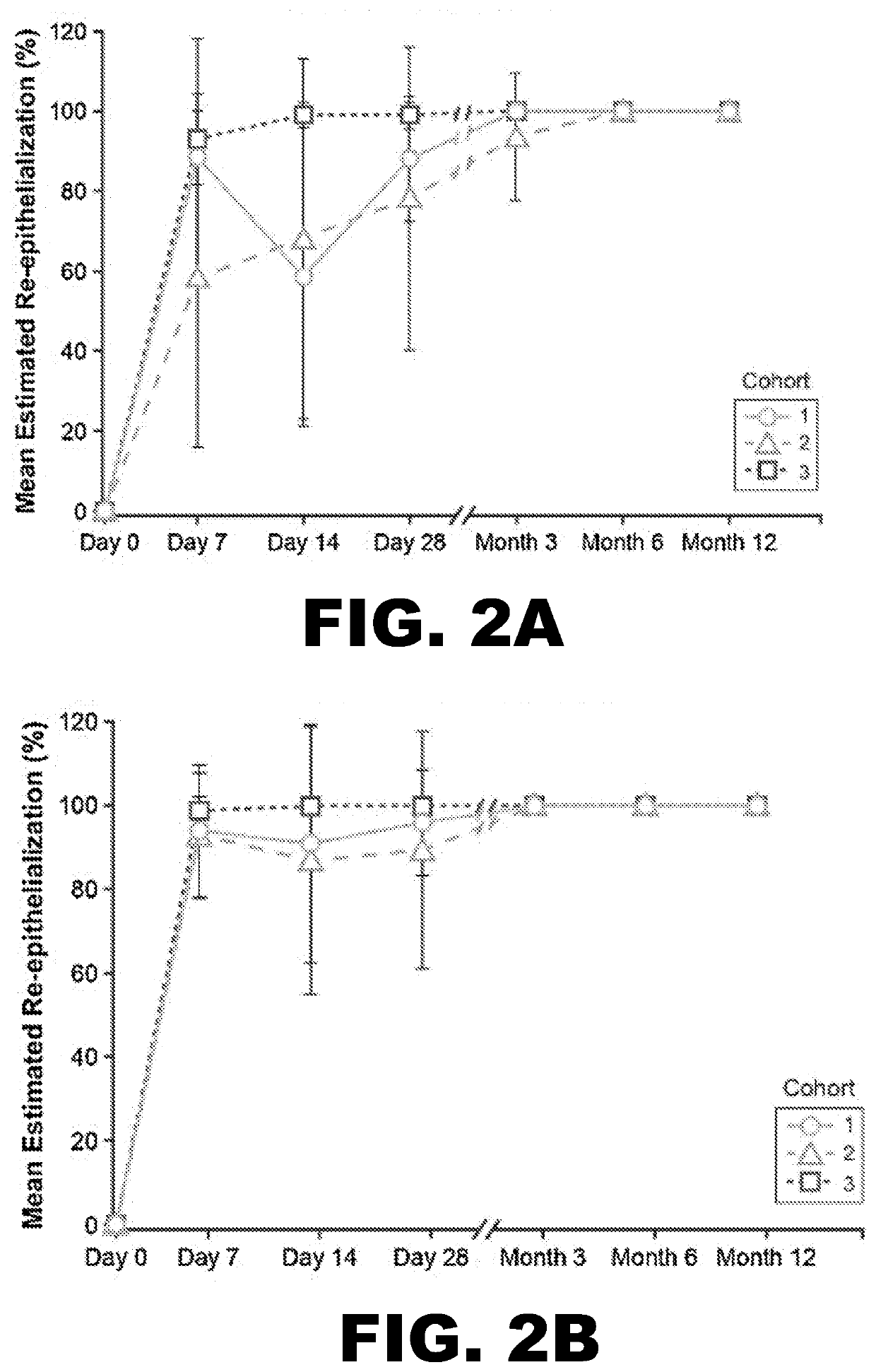Methods for treating acute wounds and improving outcomes
a wound and acute treatment technology, applied in the field of acute wound treatment and improving outcomes, can solve the problems of reducing and improving the quality of life of patients, iatrogenic donor site wounds, and limited surface area for young children, so as to improve the quality of life, improve pigmentation, and improve the effect of vascularity
- Summary
- Abstract
- Description
- Claims
- Application Information
AI Technical Summary
Benefits of technology
Problems solved by technology
Method used
Image
Examples
example 1
[0086]To evaluate whether StrataGraft could be used to reduce the need for pain in complex thermal burn wounds that contain dermal elements (“DPT thermal burns”), the skin substitute was evaluated in a prospective, randomized, controlled, open-label study that assessed the safety, tolerability, and efficacy of increasing amounts of a single application of StrataGraft compared to autograft.
[0087]The study was conducted with 3 cohorts at 6 burn centers in the United States. Subjects were sequentially enrolled into the first 2 cohorts, stratified by maximum-allowed treatment-area size, and received StrataGraft tissue that had been stored refrigerated (2° C.-8° C.). Cohorts 1 and 2 were treated with 220 cm2 and 440 cm2 of StrataGraft tissue, respectively. The third cohort was treated with 440 cm2 of StrataGraft tissue that was cryopreserved (stored at −70° C. to −90° C.) and thawed just prior to application. Target wound size was determined as a factor of the production size of StrataGr...
example 2
[0103]This example reports the findings of a post hoc analysis of the trial described in Example 1, reporting patient outcomes according to the size of the StrataGraft treatment area (2 vs. ≥200 cm2).
[0104]By Day 28, no subject in either treatment-sized group received autograft at the StrataGraft treatment site. By Month 3, the mean percent area of the StrataGraft treatment site that had received autograft was 1.7±6.5% and 7.1±26.7% in the 2 group (92.0±13.9% vs. 97.3±10.3%; P=0.31) or in the ≥200 cm2 group (83.6.0±33.0% vs. 92.5±24.1%; P=0.25). Donor-site pain at prospective unharvested StrataGraft treatment sites was significantly lower than at autograft donor sites through Day 14 for subjects in both treatment-size groups (data now shown). Finally, the mean POSAS total scores (determined independently by clinical observer and subject) for StrataGraft and autograft treatment sites at Month 12 are summarized Table 5.
TABLE 3Subject demographics and baseline characteristicsby size of...
example 3
[0105]A phase 3 open-label randomized controlled study (NCT03005106) was performed to evaluate whether treatment with StrataGraft skin tissue can promote the healing of complex skin defects due to thermal burns that contain intact dermal elements and for which surgical excision and autografts are indicated.
[0106]Study design: The study was conducted at 12 burn centers in the United States. Randomization schemes were generated via a customized program (WuXi Clinical, Austin, Tex.) prior to the study, and randomization assignments for the treatment sites of each study patient were provided in sealed envelopes. The treated wounds were classified as deep partial thickness (DPT) thermal burns that contained intact dermal elements and were clinically indicated for excision and grafting. Following surgical excision of nonviable tissue, two comparable areas of equivalent depth were identified by the surgeon, labeled “A” and “B,” and randomly assigned to receive StrataGraft or autograft (int...
PUM
| Property | Measurement | Unit |
|---|---|---|
| surface area | aaaaa | aaaaa |
| surface area | aaaaa | aaaaa |
| time | aaaaa | aaaaa |
Abstract
Description
Claims
Application Information
 Login to View More
Login to View More - R&D
- Intellectual Property
- Life Sciences
- Materials
- Tech Scout
- Unparalleled Data Quality
- Higher Quality Content
- 60% Fewer Hallucinations
Browse by: Latest US Patents, China's latest patents, Technical Efficacy Thesaurus, Application Domain, Technology Topic, Popular Technical Reports.
© 2025 PatSnap. All rights reserved.Legal|Privacy policy|Modern Slavery Act Transparency Statement|Sitemap|About US| Contact US: help@patsnap.com



